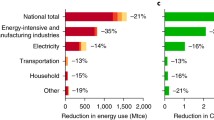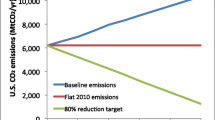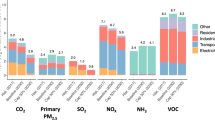Abstract
This study examines a hithertoneglected set of benefits from climate policy,viz., the reduction in emissions of localair pollutants and the associated healthbenefits, in this case for residents ofSantiago de Chile. By using an economy-widemodel, we are able to compare these monetisedbenefits to the direct costs of carbonabatement, thereby determining the scope for “no regrets” CO2 reductions. Sensitivityanalysis is performed in recognition of theuncertainty surrounding certain key parameterand exogenous variable values – notably,households' willingness to pay (WTP) forreduced mortality and morbidity risk, and thesubstitution elasticities among energy sourcesand between energy and other inputs. Ourresults suggest that, even with the mostconservative assumptions (low WTP, lowelasticities), Chile could reduce CO2emissions by almost 20% from the 2010 baselinewith no net welfare loss, though a 10%reduction is closer to “optimal”. If insteadChile were to target a 20% reduction inparticulate concentrations, a particulate taxwould incur slightly lower costs than anequivalent carbon tax to achieve the samehealth benefits. While the latter is asecond-best method of addressing localpollution, the welfare loss of choosing thisinstrument could be fully compensated by carboncredit sales at a world market price of$20/tC.
Similar content being viewed by others
References
Alberini, A., M. Cropper, T.-T. Fu, A. Krupnick, J.-T. Liu, D. Shaw and W. Harrington (1997), ‘Valuing Health Effects of Air Pollution in Developing Countries: The Case of Taiwan’, Journal of Environmental Economics and Management 34, 107–126.
Armington, P. (1969), ‘A Theory of Demand for Products Distinguished by Place of Production’, IMF Staff Papers 16(1), 159–178.
Ayres, R. U. and J. Walter (1991), ‘The Greenhouse Effect: Damages, Costs and Abatement’, Environmental and Resource Economics 1, 237–270.
Barker, T. and K. E. Rosendahl (2000), ‘Ancillary Benefits of GHG Mitigation in Europe: SO2, NOx, and PM-10 reductions to meet Kyoto targets using the E3ME model and EXTERNE valuations’, in OECD, op. cit., 413–451.
Beghin, J. and S. Dessus (1999), ‘Double Dividend with Trade Distortions: Analytical Results and Evidence from Chile’, Working Paper 99-WP 225, Center for Agricultural and Rural Development, Iowa State University, Ames, September.
Beghin, J., D. Roland-Holst and D. van der Mensbrugghe (1994), ‘Trade and Pollution Linkages: Piecemeal Reform and Optimal Intervention’, Technical Paper No. 99, OECD Development Centre, Paris, October.
Beghin, J., S. Dessus, D. Roland-Holst and D. van der Mensbrugghe (1996), ‘General Equilibrium Modelling of Trade and the Environment’, Technical Paper No. 116, OECD Development Centre, Paris, September.
Beghin J., B. Bowland, S. Dessus, D. Roland-Holst and D. van der Mensbrugghe (2002), ‘Trade Integration, Environmental Degradation, and Public Health in Chile: Assessing the Linkages’, Environment and Development Economics 7, 45–71.
Boyd, R., K. Krutilla and W. K. Viscusi (1995), ‘Energy Taxation as a Policy Instrument to Reduce CO2 Emissions: A Net Benefit Analysis’, Journal of Environmental Economics and Management 29, 1–24.
Burniaux, J.-M., G. Nicoletti and J. Oliveira-Martins (1992), ‘GREEN: A Global Model for Quantifying the Costs of Policies to Curb CO2 Emissions’, OECD Economic Studies 19, 49–92.
Burtraw, D. and M. Toman (1997), ‘The Benefits of Reduced Air Pollutants in the U.S. From Greenhouse Gas Mitigation Policies’, Discussion Paper 98-01-REV, Resources for the Future, Washington, D.C., November.
Bussolo, M. and D. O'Connor (2001), ‘Clearing the Air in India: The Economics of Climate Policy with Ancillary Benefits’, OECD Development Centre Technical Paper No. 182, Paris, November.
Cifuentes, L. A., E. Sauma, H. Jorquera and F. Soto (1999), ‘Co-Controls Benefits Analysis for Chile: Preliminary Estimation of the Potential Co-Control Benefits for Chile’, COP-5 Progress Report, School of Engineering, Pontifical Catholic University of Chile, October, revised 12 November.
Cifuentes, L. A., J. Vega, K. Köpfer and L. B. Lave (2000), ‘Effect of the Fine Fraction of Particulate Matter versus the Coarse Mass and Other Pollutants on Daily Mortality in Santiago, Chile’, Journal of the Air and Waste Management Association 50, 1287–1298.
Cifuentes, L. A., J. J. Prieto and J. Escobari (2001), ‘Valuing Mortality Risk Reduction at Present and Future Ages: Results from a Contingent Valuation Study in Chile’, Santiago, mimeo.
CONAMA (1997), Plan de Prevencion y Descontaminacion Atmosférica de la Region Metropolitana, 1 July, Santiago.
Cropper, M. L., N. B. Simon, A. Alberini and P. K. Sharma (1997), ‘The Health Effects of Air Pollution in Delhi, India’, World Bank Policy Research Department, Working Paper No. 1860, December.
DeCanio, S. J. (1998), ‘The Efficiency Paradox: Bureaucratic and Organizational Barriers to Profitable Energy-Saving Investment’, Energy Policy 26(5), 441–454.
Dessus, S. and D. O'Connor (1999), ‘Climate Policy without Tears: CGE-Based Ancillary Benefits Estimates for Chile’, Technical Paper No.156, OECD Development Centre, Paris.
Dessus, S., D. Roland-Holst and D. van der Mensbrugghe (1994), ‘Input-Based Pollution Estimates for Environmental Assessment in Developing Countries’, Technical Paper No. 101, OECD Development Centre, Paris.
Desvousges, W. H., F. R. Johnson and H. S. Banzhaf (1998), Environmental Policy Analysis with Limited Information: Principles and Applications of the Transfer Method. Cheltenham, U.K.: Edward Elgar.
Ekins, P. (1995), ‘Rethinking the Costs Related to Global Warming: A Survey of the Issues’, Environmental and Resource Economics 6, 231–277.
Ekins, P. (1996), ‘How Large a Carbon Tax is Justified by the Secondary Benefits of CO2 Abatement?’, Resource and Energy Economics 18, 161–187.
EPA (1997), ‘Appendix D: Human Health and Welfare Effects of Criteria Pollutants’, in The Benefits and Costs of the Clean Air Act, 1970 to 1990, Washington, D.C.
EPA (2000), Developing Country Case-Studies: Integrated Strategies for Air Pollution and Greenhouse Gas Mitigation. Progress Report for the International Co-Control Benefits Analysis Program, November, Washington, D.C.
Eskeland, G. S. and J. Xie (1997), ‘Acting Globally while Thinking Locally: Is the Global Environment Protected by Transport Emission Control Programs?’, World Bank, Washington, D.C., processed.
Garbaccio, R. F., M. S. Ho and D. W. Jorgenson (2000), ‘The Health Benefits of Controlling Carbon Emissions in China’, Kennedy School of Government, Harvard University, 16 March, processed.
Hettige, H., P. Martin, M. Singh and D. Wheeler (1995), ‘The Industrial Pollution Projection System’, Policy Research Working Paper 1431, The World Bank, Washington, D.C., March.
IEA (1998), CO 2 Emissions from Fuel Combustion, 1971–1996. IEA/OECD, Paris: IEA Statistics.
INIA (1997), Project “Greenhouse Gas Inventory for the Non Energy Sector: Agriculture, Forestry and Land Use Change”. Department of Natural Resources and Environment, Ministry of Agriculture, Chile, November.
Krupnick, A., K. Harrison, E. Nickell and M. Toman (1996), ‘The Value of Health Benefits from Ambient Air Quality Improvements in Central and Eastern Europe: An Exercise in Benefits Transfer’, Environmental and Resource Economics 7, 307–332.
Krupnick, A., A. Alberini, R. Belli, M. Cropper and N. Simon (1999), ‘New Directions in Mortality Risk Valuation and Stated Preference Methods: Executive Summary’, Office of Research and Development, U.S. Environmental Protection Agency (EPA), Washington, D.C. (http://es.epa/gov/ncerqa/final/krupnick.html).
Liu, J.-T., J. K. Hammitt and J.-L. Liu (1997), 'Estimated Hedonic Wage Function and Value of Life in a Developing Country”, Economic Letters 57, 353–358.
Liu, J.-T., J. K. Hammitt, J.-D. Wang and J.-L. Liu (2000), ‘Mother's Willingness to Pay for Her Own and Her Child's Health: A Contingent Valuation Study in Taiwan’, Health Economics 9, 319–326.
Loehman, E. and V. H. De (1982), ‘Application of Stochastic Choice Modelling to Policy Analysis of Public Goods: A Case Study of Air Quality Improvements’, Review of Economics and Statistics 64(3), 474–480.
Lvovsky, K., G. Hughes, D. Maddison, B. Ostro and D. Pearce (1999), Environmental Costs of Fossil Fuels: A Rapid Assessment Method with Application to Six Cities. World Bank, processed.
Markandya, A. (1998), ‘The Indirect Costs and Benefits of Greenhouse Gas Limitations’, Handbook Reports: Economics of Greenhouse Gas Limitations. UNEP Collaborating Centre on Energy and Environment, Riso National Laboratory, Roskilde, Denmark.
Markandya, A. and R. Boyd (1999), ‘The Indirect Costs and Benefits of Greenhouse Gas Limitations: Mauritius Case Study’, Handbook Reports: Economics of Greenhouse Gas Limitations. UNEP Collaborating Centre on Energy and Environment, Riso National Laboratory, Roskilde, Denmark.
Mitchell, R. C. and R. T. Carson (1986), Valuing Drinking Water Risk Reduction Using the Contingent Valuation Method: A Methodological Study of Risks from THM and Giardia. Report to the U.S. Environmental Protection Agency, Washington, D.C.
O'Ryan, R. (1996), ‘Cost-Effective Policies to Improve Urban Air Quality in Santiago, Chile’, Journal of Environmental Economics and Management 31, 302–313.
Ostro, B., J. M. Sanchez, C. Aranda and G. S. Eskeland (1996), ‘Air Pollution and Mortality: Results from a Study of Santiago, Chile’, Journal of Exposure Analysis and Environmental Epidemiology 6(1), 97–114.
Ostro, B., G. S. Eskeland, T. Feyzioglu and J. M. Sanchez (1998), ‘Air Pollution and Health Effects: A Study of Respiratory Illness Among Children in Santiago, Chile’, March, processed.
Pearce, D. (1992), ‘The Secondary Benefits of Greenhouse Gas Control’, CSERGE Working Paper 92–12, Revised, April.
Rogat, J., E. Figueroa and L. Firinguetti (1996), ‘An Estimation of the Economic Value of Air Quality Improvement Program in Santiago de Chile’, EEU Reprint Series No. 1996:3, Environmental Economics Unit, Göteborg University.
Sadoulet, E. and A. de Janvry (1995), Quantitative Development Policy Analysis. Baltimore: John Hopkins University Press.
Schwartz, J. (1994), ‘Air Pollution and Daily Mortality: A Review and Meta-Analysis’, Environmental Research 64, 36–52.
Simon, N. B., M. L. Cropper, A. Alberini and S. Arora (1999), ‘Valuing Mortality Reductions in India: A Study of Compensating Wage Differentials’, Working Paper No.2078, World Bank Policy Research Department, January.
UNDP (2000), Human Development Report 2000 Statistical Annex, downloaded from UNDP Human Development Report website: http://www.undp.org/hdro/highlights/statistics.html.
Viscusi, W. K. (1993), ‘The Value of Risks to Life and Health’, Journal of Economic Literature 31, 1912–1946.
Wang, X. and K. R. Smith (1999), Near-Term Health Benefits of Greenhouse Gas Reductions: A Proposed Assessment Method and Application in Two Energy Sectors of China. World Health Organisation, Geneva: Department of Protection of the Human Environment (WHO/SDE/PHE/99.01), March.
Weitzman, M. L. (1974), ‘Prices vs. Quantities’, Review of Economic Studies 41, 477–491.
WHO (1989), Management and Control of the Environment. WHO/PEP/89.1, Geneva.
Working Group on Public Health and Fossil-Fuel Combustion (1997), ‘Short-Term Improvements in Public Health from Global-Climate Policies on Fossil-Fuel Combustion: An Interim Report’, The Lancet 350(9088), 1341–1349.
World Bank (1994), Chile. Managing Environmental Problems: Economic Analysis of Selected Issues, 19 December (Report No. 13061-CH).
World Bank (1998), World Development Report 1998/99: Knowledge for Development. Washington, D.C.: Oxford University Press for The World Bank.
Xu, X., J. Gao, D. W. Dockery and Y. Chen (1994), ‘Air Pollution and Daily Mortality in Residential Areas of Beijing, China’, Archives of Environmental Health (July/August) 49(4), 216–222.
Author information
Authors and Affiliations
Rights and permissions
About this article
Cite this article
Dessus, S., O'Connor, D. Climate Policy without Tears CGE-Based Ancillary Benefits Estimates for Chile. Environmental and Resource Economics 25, 287–317 (2003). https://doi.org/10.1023/A:1024469430532
Issue Date:
DOI: https://doi.org/10.1023/A:1024469430532




